Rosa, Rose, Mei Gui Hua 玫瑰花Mei Gui Hua (TCM)Ward, Gulab (Unani) Se ba’i me tog སེ་བའི་མེ་ཏོག (Tibet) |

|
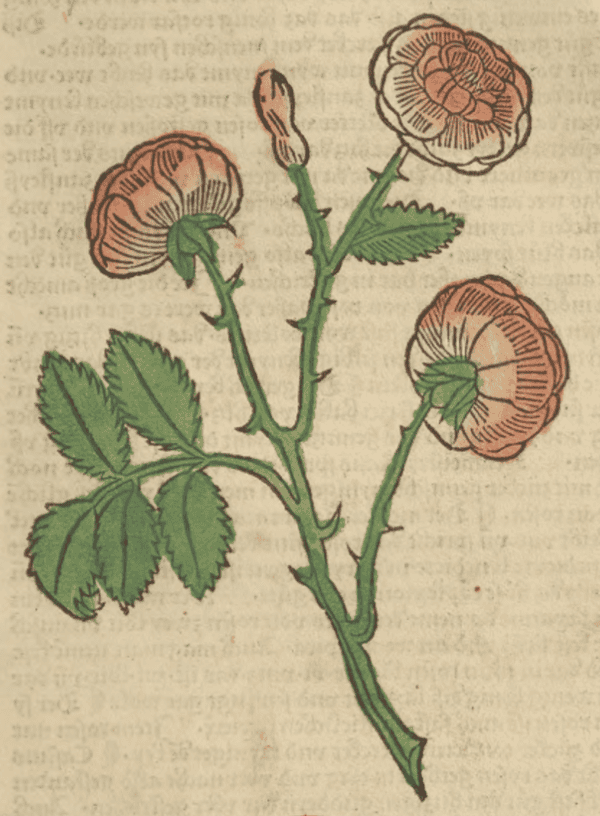 Gart der Gesundheit, Cuba, 1485
Gart der Gesundheit, Cuba, 1485
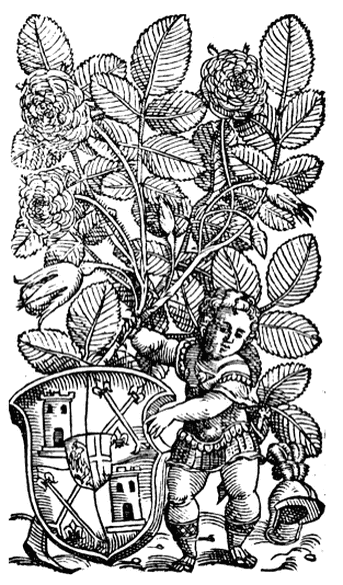
|
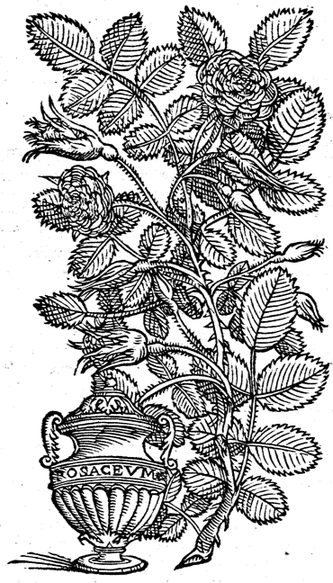
|
|
Della Materia Medicinale Andrea Valuassori, 1562 |
Dioscorides Materia Medica, Mathias, 1563 |
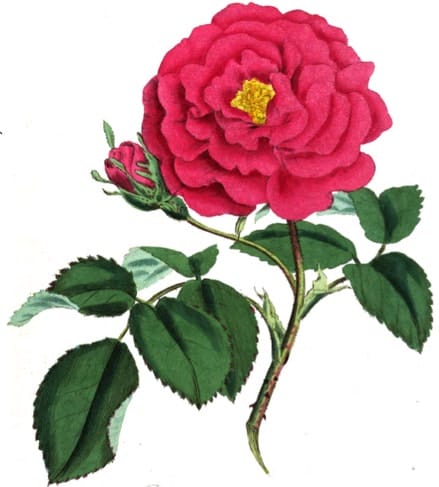 Rosa gallica
Rosa gallicaMedical Botany, Woodville, Hooker, Vol. 3, 1832 |
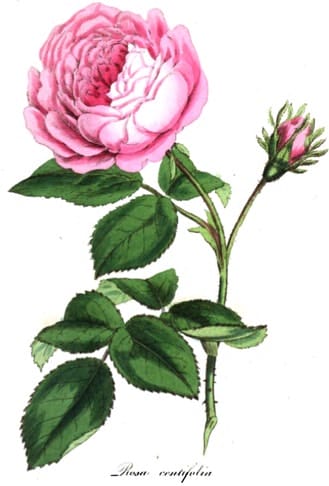 Rosa centfolia
Rosa centfoliaMedical Botany, Woodville, Hooker, Vol. 3, 1832 |
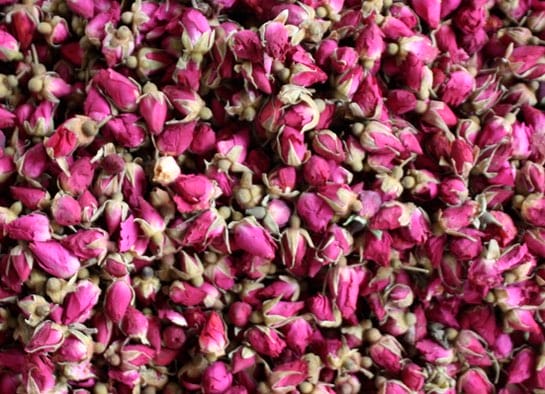 Rose buds used for tea and medicine
Rose buds used for tea and medicineBotanical name:
Rose spp. Several varieties are used:
1. Gallic or Red Rose: R. gallica;
2. Damask Rose: R. damascena
3. Hundred-leaved Rose, Pale Rose: R. centifolia
TCM uses 2 types of Rose flower: Mei Gui Hua (R. rugosa) and Yue Ji Hua (R. chinensis). Both have similar uses, moving the Qi and Blood, useful for premenstrual symptoms and abdominal pain. The former moves the Qi, the latter more strongly moves the Blood. Mei Gui Hua affects the Liver, Spleen and Stomach, and is more similar to the use of Rose in the West.
In Tibetan Medicine, R. moschata (syn. R. brunoni), R. omeiensis and R. davurica are used. R. moschata is distilled in Himachal Pradesh for Rose water and otto, the flowers being used for Hot and Bile disorders as for the use of Rose in the West..
Parts used:
Flower buds; Juice of the flowers
Temperature & Taste:
Mildly Cool and Dry. Pungent, Sweet, slightly Bitter, Aromatic
It is most Cool and Bitter when fresh,
“Galen opined that the Rose is not very cold in relation to the human body. It may be cold in the first degree. I consider the rose, particularly in its dried state, to be cold in the first phase of the second degree” (Avicenna)
Classifications:
2A APERIENT. 2H. CARMINATIVE. 2N. REPELLENTS. 2O. ASTRINGENT. 2P. HEMOSTATIC. 2S. STRENGTHENING. 2T. GLUTINATE
2Z. CICATRIZING
3B. FEBRIFUGE & ANTIPYRETIC. 3D. CORDIALS & CARDIACS. 3L. ANTI-TUSSIVE
4a. CEPHALIC. 4c. CARDIAC. 4d. PECTORAL. 4e. STOMACHIC. 4g. HEPATIC. 4i. UTERINE. 4j. NERVINE.
4k. ARTHRITIC
Uses:
1. Benefits the Heart, Liver, Stomach and Spleen:
-benefits and regulate the Heart, Liver, Spleen and Stomach
-used when heat, damp or Qi stagnation affects any of these organs
-strengthen and refresh the Vital Spirit (Qi) and Animal Spirits (Spirit)
-particularly good to support the Stomach; clears Damp, promotes Appetite and regulates digestion
-“Both the flowers and their juice are useful in the ‘wetness’ of the stomach” (Avicenna)
2. Astringes to Stop Leakage:
-binding; used for all types of Fluxes (red is strongest, then the White)
-some said the Red was best for Uterine Bleeding, and the White was best for Leukorrhea.
-excess sweating
3. Clears Heat, Calms the Mind and Settles the Spirit:
-Fever, and Thirst in Fevers
-Palpitations
-Anxiety, Depression, Irritability, Insomnia and Post-natal depression
-traditionally used for Melancholy
-traditionally regarded as increasing calmness, compassion and opening the Heart to love
4. Clears Heat, Stops Bleeding:
–Leukorrhea, Uterine Bleeding, Spermatorrhea, as well as Diarrhea and Dysentery.
-Spitting of Blood.
5. Clears Liver Heat, Eases the Liver, removes Constraint:
-headache, and pains in the eyes, ears, throat and gums
-Liver diseases, abscesses, and blood diseases (Li Shi Chen)
-menstrual irregularities, irritability and anger associated with Liver heat, or Qi stagnation
6. Regulates the Blood and Menstruation, Benefits Reproduction:
-delayed or irregular menstruation and menstrual pain from constrained Qi, or mild blood stasis.
-regulates menstruation, promotes regular ovulation; also Frigidity.
-Infertility, Sterility, and Impotence, and was said to ‘increase Semen’.
-Dysmenorrhea, Metrorrhagia
-Endometriosis, Fibroids, Polycystic Ovary Syndrome
-PMS
-benefits Menopausal women, specifically hot flushes, irritability
–Hippocrates used Rose widely in gynecological and obstetric disorders.
7. Damask Roses are gently laxative:
-Pale or Damask Roses loosen the belly
-Avicenna said 35 grams of fresh Red Rose is laxative
-juice of the Flowers purges Choler, Phlegm and Water.
8. Externally:
-“Application of a plaster prepared from a decoction of powdered flowers without squeezing, dissolves hot inflammations and proves useful in erysipelas” (Avicenna)
-externally for Vomiting and Stomachache (over the Stomach), Pain of the Abdomen (topically)
-Headache (forehead and temples), Earache
-sore Gums, Ulcers and Inflammations of the Mouth and Gums, Jaws and Eyes (often boiled in Wine, or Rose water may be used)
-“useful for treating ulcers. It promotes granulation in chronic ulcers” (Avicenna)
-the yellow anthera from the center of the Flowers was used in Dentrifices to tighten and strengthen the Teeth and Gums
-used in Baths or washes for foul smelling perspiration (Avicenna)
-“useful in conjunctivitis” (Avicenna)
-“An enema with its decoction is useful in cases of intestinal ulcers” (Avicenna)
Dose:
“Fresh flowers taken in a dose of 10 dirham (35 gm) act as a purgative resulting in ten motions. The dry flowers elicit no such action” (Avicenna)
Powder: 500mg–3 grams
Brief Decoction or Infusion: 3–6 grams
Correctives:
1. Aniseed
2. Mastic
Substitutes:
1. Marjoram
2. Violet flower
Main Combinations:
Aloe & Rose
Rose & Sandalwood
Rose, Sandalwood & Licorice
Heat, Bile:
1. To purge Choler (Bile) and Melancholy, Rose with Senna, Caraway and Fennel seed (as in Syrup of Rose Solutive with Senna)
2. To clear Heat and Bile:
i. Ros ewith Emblic Myrobalan, Tinospora
ii. Rose with Sandalwood, Tragacanth, Licorice and Pearl
iii. Rose with Tabasheer, Purslane seed, Licorice juice, Tragacanth (as in Troches of Spodium of Nicholas)
iv. Syrup of Rose Solutive
Heart:
3. To strengthen the Heart:
i. Rose with Cinnamon and Licorice
ii. Rose with Amber, Bugloss, Balm, Cinnamon, Saffron, Red Coral, Sandalwood (as in Powder to Strengthen the Heart)
iii. Rose with Tabasheer, Coriander, Amber, Pearl, Musk (as in Cooling Electuary of Musk of Rhazes)
4. Palpitation:
i. Rose, Aloeswood, Saffron, Red Coral
ii. Rose, Sandalwood, Saffron, Red Coral, Amber
Mind, Brain:
5. Balance the Spirit, Mind and Nerves, Harmonise the Liver, Spleen and Heart, Rose, Sandalwood, Aloeswood, Cinnamon, Licorice, Pearl
6. Melancholy and Stomach weakness:
i. Rose with Orange peel, Nutmeg, Cinnamon, Calamus, Juniper berry, Balm, Sage, Rosemary
7. Insomnia:
i. Poppy head decoction with Rose water and Wild Lettuce Water added (Herbarium Horstianum, 1630)
ii. Rose water mixed with emulsion of Poppy seed applied to the forehead and temples (Herbarium Horstianum, 1630)
8. Calm the Spirit, levigated Pearl, Red Coral and Amber with Rose Water
9. Dementia, Old Age:
i. Rose, Balm, Sage, Rosemary, Frankincense
ii. Rose, Chebula, Indian Spikenard, Saffron
Stomach/Liver:
10. Stomach weakness:
i. Rose with Aloe and Mastic (as in Stomach Pills of Mesue)
ii. Rose with Licorice, Cinnamon, Sandalwood and Cardamon
iii. Rose with Wormwood, Indian Spikenard (as in Syrup of Wormwood)
iv. Rose with Sandalwood, Lesser Cardamon, Cinnamon, Saffron, Mastic, Spikenard, Fennel seed. (Pharmacopoeia Sardoa, 1773)
v. Rose with Sandalwood, Licorice, Aniseed, Cinnamon, Spikenard, Rhubarb, Saffron, Mastic, Mother of Pearl (Dispensatorium medico pharmaceuticum Palatinatus, 1764)
11. Abdominal pain, Indigestion, chronic Fever:
i. Rose with Aloeswood, Mastic, Wormwood, Cinnamon, Spikenard (as in Troches of Rose of Rhasis)
12. Gastric Ulcer, Damask Rose, Licorice, Indian Spikenard (see research below)
13. Liver Heat and obstruction:
i. Rose with Orris, Rhubarb, Lacca, Cassia wood, Saffron (as in Electuary of Rose of Unani)
i. Liver heat and inflammation, Rose water with Diarrhodon Abbatis and Diasantalum (Herbarium Horstianum, 1630)
14. Strengthen the Liver:
i. decoction of Rose (Herbarium Horstianum, 1630)
ii. Rose, Sandalwood, Licorice
iii. Rose, Balm, Agrimony, Dodder
15. Dysentery: Conserve of Red Rose (4 oz.) dissolved in Decoction of Mullein flower (Fouquet)
Leakage, Bleeding:
16. As an astringent:
i. Astringent Electuary: Conserve of Rose, Red Earth, Dragons Blood, Pomegranate flowers, Nutmeg, Cinnamon, form an Electuary with Syrup of Rose (Pharmacopoeia Hispana, 1798)
ii. Rose, of each of the 5 Myrobalans, bruised (half oz. each), Water (1 pound). Digest warm, add to the strained liquor Syrup of Pomegranates (half oz.). Mix. For Diarrhea and Hemorrhages. (Formulaire de Montpellier, 1822)
17. Spitting Blood (Hemoptysis):
i. Old Conserve of Rose
ii. Rose, Red Coral, Red Earth, Tabasheer, Licorice
iii. Rose, Tragacanth, Poppy seed, Plantain
Gynecology, Obstetrics:
18. Amenorrhea, Dysmenorrhea, Uterine Pain, Rose with Saffron, Ammi, Myrrh (as in Troches of Saffron of Nicholas)
19. PMS, Rose, Cyperus rotundus, Peony root
20. Menopause:
i. Rose, Sandalwood, Cinnamon
ii. Rose, Pearl, Red Coral
iii. Rose, Sage, Ladies Mantle
21. Excessive Menstruation:
i. Rose root decocted in water to stop excessive menstruation (Herbarium Horstianum, 1630)
ii. with clotting and pain, Rose with Safflower (or Saffron), Asparagus root, Turmeric
iii. Rose with Rhubarb, Red Coral, Red Earth (as in Powder for Excessive Menstrual Bleeding)
22. Leukorrhea:
i. Rose with Rosemary, Elecampane (Nouveau Formulaire Medicale et Pharmaceutique, 1820)
23. Infertility, Rose, Withania, Asparagus root, Mucuna, Tribulus
24. Prevent Miscarriage, Rose with Kermes, Red Sandalwood, Red Coral, Mastic, Nutmeg (Pharmacopoeia Wirtembergica, 1798)
Other:
25. Phthisis, Consumption:
i. Conserve of Roses alone was effective, especially in the young
ii. Conserve of Rose, Conserve of Violet, Diamoschu Dulce (Sweet Powder of Musk) (Herbarium Horstianum, 1630)
iii. Rose juice mixed with Sugar into tablets
iv. Conserve of Rose, Tragacanth Cooling Powder, Cooling Pearl Powder
v. Rose water, Mint juice, Hyssop, Licorice and Sugar (Natura exenterata, Philiatros, 1655)
26. Incipient Edema: Troches of Rose with Diarrhodon Abbatis (Herbarium Horstianum, 1630)
27. Cachexia, Rose, Agrimony, Cinnamon, Licorice
Externally:
28. Skin inflammation:
i. apply Rose water with a little Rose vinegar
ii. Rose, Madder, Chrysanthemum, Neem
29. Headache:
i. apply Rose water to the temples and forehead
ii. and to soothe inflammations, Rose water, Oil of Roses, Vinegar, mixed and applied
30. A water to benefit the sight and clear Heat of the Eyes, mix Rose water with Eyebright water and drop in the eyes.
31. Gargle for Sore Throat, Honey of Rose dissolved in Barley Water
Major Formulas:
Syrup of Rose Solutive (Syrupus Rosaceus Solutivus)
Aromatic Rose Compound (Aromaticum Rosatum)
Abbots Confect of Rose (Diarrhodon Abbatis) (Nicholas)
New Rose Powder (Rosata Novella) (Nicolas)
Troches of Rose (Rhasis)
Troches of Rose (Trochisci Diarrhodon) (Nicholas)
Troches of Rose (Trochisci Diarrhodon) (Mesue)
Troches of Rose Lesser (Mesue)
Troches of Rose Greater (Mesue)
Troches of Rose and Agrimony (Mesue)
Christian Electuary (Unani)
Electuary of Rose (Unani)
Electuary of the Juice of Roses (Mesue)
Electuary to Conquer
Electuary for Stomach Debility (Unani)
Letificans Temperate Electuary
Stomach Pills (Mesue)
Powder to Strengthen the Heart (Wirtzung)
Powder for Excessive Menstrual Bleeding (Wirtzung)
Powder for Vomiting of Blood
Tincture of Life (Mynsichts)
Bile Conqueror (Mkhris las rnam rgyal) (Tibetan)
Lotus Stem White Pills (Ril dkar pad sdong) (Tibetan)
Pomegranate 8 Petalled Lotus (Se ‘bru pad ma ‘dab brgyad) (Tibetan)
Cautions:
Generally Safe.
1. Allergy: Susceptible people may develop sneezing, inflammation of the eyes, fainting, hysteria and even miscarriage (Medical Botany, Woodville, Hooker, Vol. 3, 1832). However, it is generally safe and very well tolerated, and such reactions are probably due to large doses of Rose used alone.
Main Preparations used:
Vinegar of Red Roses, Distilled Waters of Red, Damask and White Roses, Conserves of the Red and Damask Flowers Sugar of Roses (made of the juice and sugar), Distilled Oil, Tincture, Infused Oil (Simple and Compound), Manus Christi (with and without Pearl), Aloes Rosata, Ointment of Roses
1. Syrup of Red Rose:
i. Dried petals of Red Rose (1 part), Boiling Water (9 parts), White Sugar (10 parts). Macerate the petals for 12 hours, then boil a little, strain. Add the sugar and boil to a syrup. (Edinborough)
ii. Dried petals of Red Rose (8 oz.), Boiling Water (5 ½ pounds), Digest 12 hours, boil down to one half, express; set the liquor aside to depurate by repose, evaporate a little so that when Sugar (16 oz.) is added a syrup is formed without boiling. (Pharmacopoeia Amstelodamensis, 1792)
2. Syrup of Rose Solutive, Syrup of Pale Rose:
i. Dried Pale Rose petals (7 oz.), White Sugar (6 lbs.), Boiling Water (4 pints). Macerate the petals for 12 hours, strain, evaporate the liquor in a water-bath till reduced to 2 ½ pints, add the sugar and form a syrup. (London)
3. Honey of Roses:
i. Dried Petals of Red Rose (4 oz.), Boiling Water (3 pints), clarified Honey (5 lbs.). Macerate the petals in Water for 6 hours; mix the honey in the strained liquor and boil to a syrup, removing the scum. (London)
ii. Fresh Red Roses (5 parts), clarified Honey (10 parts). Pound the Roses, mix with Honey and put in a glass vessel in the sun for 40 days, shaking every day. Used for heat and pain of the Stomach, Fever and Thirst. (Syrian “Book of Medicine“, trans. by Wallis Budge, 1913)
4. Vinegar of Roses:
i. Red Rose petals (1 part), Vinegar (16 parts). Macerate 15 days in a covered vessel, shaking occasionally; strain, filter.
5. Rose Water:
i. Petals of the 100 leaves Rose (centifolia) freed from their claws (8 lbs.), Water (sufficient to prevent burning). Distil one gallon. (London)
The vertues of Rose Water:
1. And if you drink Rose-water with Sugar, it will asswage all heats.
2. And if you drink it with water of Cottidony, and Feverfew and Sugar, it will destroy all manner of Jaundice.
3. And if you annoint your Temples of your head, it shall ease the head-ache.
4. And if you mix it with the juice of Fumitory and black Soap, it will destroy the Morphew.
5. And if you drink it fasting it will make a sweet breath, clear the sight, and comfort the nature.
6. And if you boyl white Copperis in it, and wash your eyes without and within, it will destroy the Pin and Web:
7. And if you drink it with the juice of Mint, Hyssop, Sugar, and Licorice, it will destroy the Tissick [phthisis)
8. And if you drink it with the juice of Sothernwood, and Fennel seed, it will destroy the Cough, and all manner of evils in the Breast, and quencheth all heats in the Stomack. (Natura exenterata, Philiatros, 1655)
6. Rose Ointment:
i. Lard (any quantity), triturate with a wooden pestle, gradually adding Rose Water until the Lard becomes snow white. (Pharmacopoeia Suecica, 1817)
ii. some added a few drops of Lavender oil at the end of the preceding. (Pharmacopoeia Rossica, 1803)
iii. Lard (10 oz.), White Wax (2 oz.), melt together and add Rose Water (3 oz.), Orange flower-water (1 oz.). Set aside for 24 hours, then pour off the water and triturate the Lard with Oil of Lavender, Oil of Lemon (of each half dram). Mix. (Niemann)
7. Compound Rose Ointment:
i. Lard (3 lbs.), Storax, Benzoin, Orris (1 oz. each), Lemons, Orange (2 of each), Rennet Apples (4), boil to the consumption of the humidity, strain, add Oil of Cinnamon, Oil of Cloves (25 drops each), then beat the whole with Spirit of Rose. (Dispensatorium medico pharmaceuticum Palatinatus, 1764)
ii. Clove (2 drams), Cinnamon, Benzoin, Storax (3 drams each), Mace (2 scruples), Lavender, Rhodium Wood, Aloeswood (1 dram each), Sassafras Wood (half dram), Orris (1 oz.), Rose Water (half pound), Lard (1 pound), Pulp of Rennet Apples (6 oz.), Goat Suet (4 oz.). Boil slowly, then digest for 3 days; then boil to the consumption of the humidity; strain; agitate the strained liquor with Rose Water until it becomes white, then add Oil of Rhodium (20 drops). Mix. (Niemann)
8. Rhodides:
i. fresh Roses, freed of moisture and withered (40 drams), Indian Spikenard (5 drams), Myrrh (6 drams); beat together and form into small discs and dry. Some add Costus and Orris (2 drams each). (Dioscorides)
These were used as perfumes by ancient Greeks, either worn, or powdered and used as dusting powders after bathing.
1. Red Rose
|
‘The use in medicine of the rose dates from a very remote period. Theophrastus speaks of roses being of many kinds, including some with double flowers which were the most fragrant; and he also alludes to their use in the healing art. Succeeding writers of every age down to a recent period have discussed the virtues of the rose, which however is scarcely now admitted to possess any special medicinal property. One of the varieties of R. gallica is the Provins Rose, so called from having been long cultivated at Provins, a small town about 60 miles south-east of Paris, where it is said to have been introduced from the East by Thibaut VI., Count of Champagne, on his return from the Crusades, A.D.1241. But it appears that he went then to Navarre and in later times never resided in the Champagne. Be this as it may, Provins became much celebrated not only for its dried rose-petals, but also for the conserve, |
syrup and honey of roses made from them,— compositions which were regarded in the light of valuable medicines. It is recorded that when, in A.D. 1310, Philippe de Marigny, arch bishop of Sens, made a solemn entry into Provins, he was presented by the notables of the town with wine, spices, and Conserve of Roses ; and presents of dried roses and of the conserve were not considered beneath the notice of Catherine de Medicis, and of Henry IV. We find that Charles Estienne, in 1536, mentions both the Rosae purpurea odoratissimase which he says are called Provinciales, and those known to the druggists as incarnatae;— the latter we presume a pale rose. Rosa rubeae are named as an ingredient of various compound medicines by Valerius Cordus. (Pharmacographia, Fluckiger & Hanbury, 1879) |
2. Damask Rose
|
‘Under the name of Ward, the following varieties of the Rose are noticed in Arabic and Persian works :— White Wild Rose, Red Wild Rose, Red Garden Rose, Wild Yellow Rose, Yellow Garden Rose, Dalik or Dog Rose, White Cluster Rose, and a wild Rose called Ward-el-Hamak, the petals of which are described as yellow outside and red within. Of these the red garden Rose appears to be the R. Damascena which is cultivated both in Persia and India for official purposes, and is the kind from which Rose Water and Oil of Roses are usually obtained. In India Rose buds are preferred for medicinal use, as they arc more astringent than the expanded flowers; they are considered to be cold and dry, cephalic, cardiacal, tonic and aperient, removing bile and cold humours; externally applied the petals are used as an astringent. The stamens are thought to be hot, dry and astringent, and the fruit is credited with similar properties. Notices of the fruit of Rosa canina will be found in Arabic works under the name of Dalik, The Rose stamens (Tukm-i-gul) of the shops are supposed to be derived from this plant. The following preparations made with the petals of R. Damascena are used as medicaments:— Duhn-i-ward-i-khdm.— A fatty oil made by exposing Rose leaves and sweet oil to the sun and then filtering. Duhn-i-ward-i-matbukh.— A similar preparation made by heating the petals with sweet oil over the fire. Both of these oils are considered to be deobstruent, astringent and aperient; they are also recommended in poisoning by caustic alkalies. Gulkand.— A conserve made from equal parts of Rose petals and white sugar beaten together; it is considered tonic and fattening, and is much used by women and old people. Sheikh-el-Rais says that he |
cured a consumptive young woman with it. Gulangabin.— A similar preparation made with honey and considered to have much the same properties. Gulab.— Rose water is largely used in native practice in much the same way as orange flower water is by the French. Gulab-ka-attar.— Otto of Roses, having properties similar to those of Rosewater, is made in Persia and India, but not in sufficient quantity to supply the Indian market; a good deal has therefore to be imported from Turkey. Rose water is manufactured in Bengal and the Punjab, and a large quantity is imported from Persia. An account of the preparation of rose water and otto at Ghazipur in Bengal will be found in the Bengal Dispensatory. It appears that the common native still is used (this is simply a rough form of alembic without a condensing worm), and that one hundred thousand roses produce about 100 bottles of rose water. Otto is only made in cold weather. To obtain it the rose water is exposed to cold in shallow vessels, a thin film forms upon the surface, and is removed with a feather. One hundred thousand roses are estimated to produce about 180 grains of otto. Otto is said to have been first discovered in India by Nur-i-jehdn Begum in 1612. On the occasion of her marriage with the Emperor Jehangir, the Queen is said to have observed a scum upon the surface of the Rosewater with which the canals in the gardens of the palace had been filled, and ordering it to be collected found it to have a delicious fragrance. For an interesting history of otto and its introduction into Europe the Pharmacographia may be consulted. (Vegetable Materia Medica of Western India, Dymock, 1885) |
